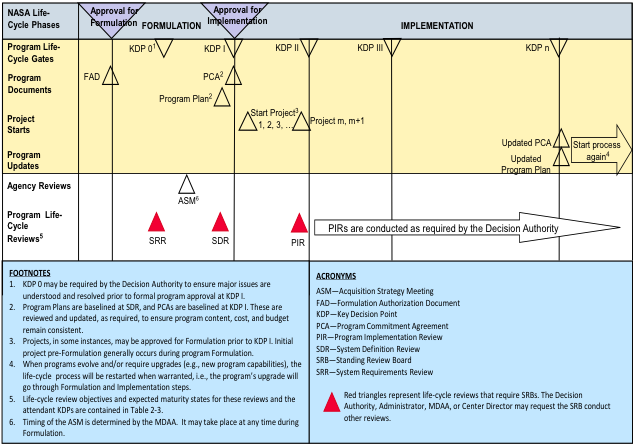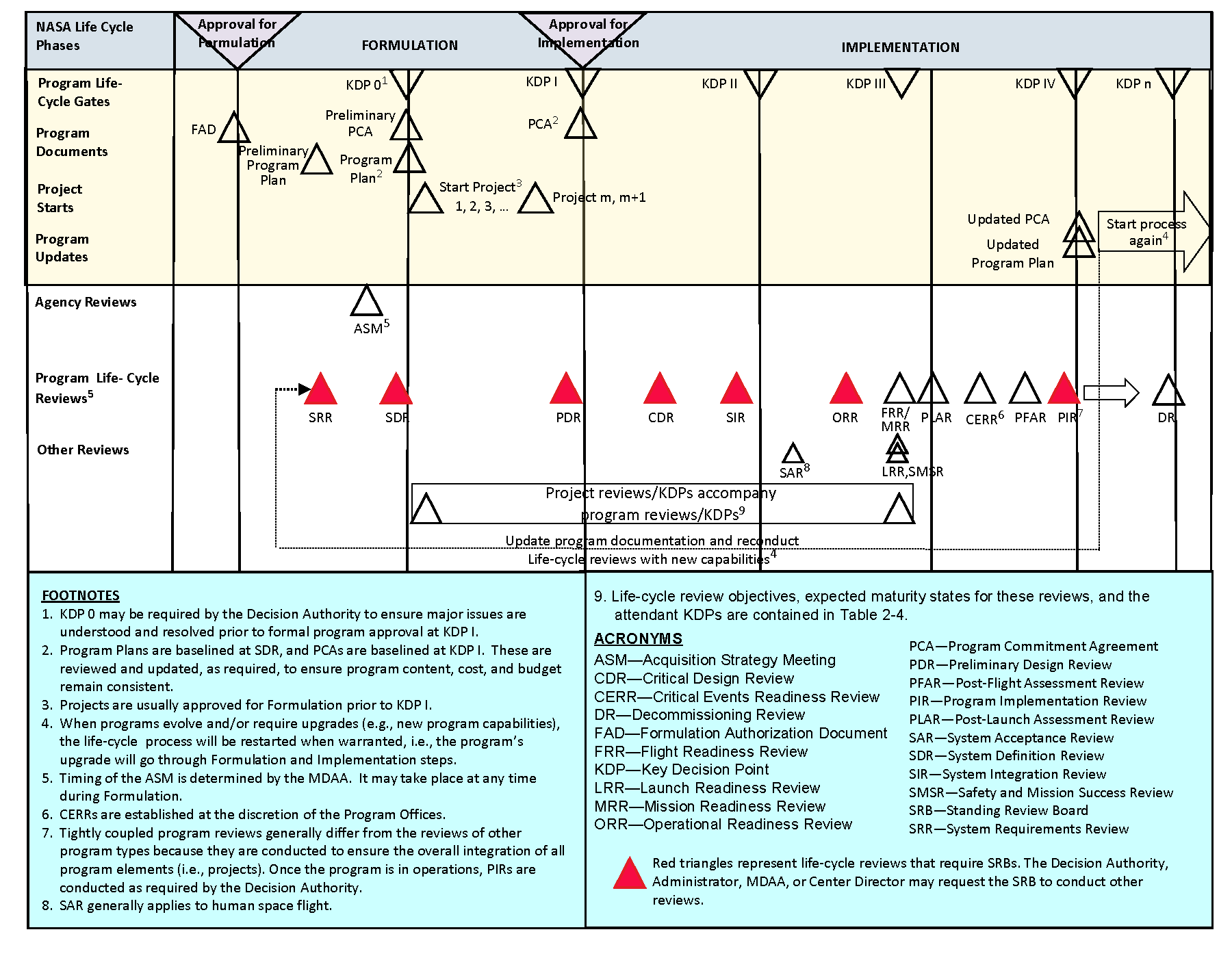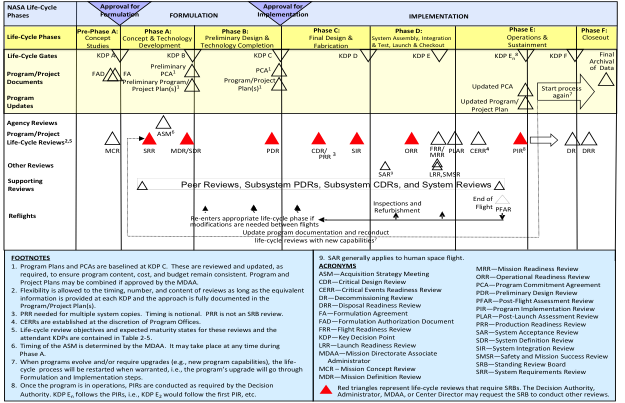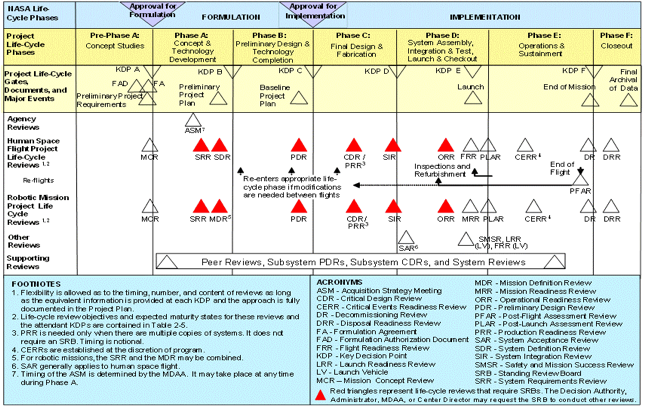
Note: For example only. Refer to NPR 7120.5 for the official life cycle. Table 2-3 in the above references is in NPR 7120.5.
Figure 5 4 - The NASA Project Life Cycle
5.1.5 Life-cycle reviews are event based and occur when the entrance criteria for the applicable review are satisfied. (Appendix G provides guidance.) They occur based on the maturity of the relevant technical baseline as opposed to calendar milestones (e.g., the quarterly progress review, the yearly summary).
5.1.6 Accurate assessment of technology maturity is critical to technology advancement and its subsequent incorporation into operational products. The program/project ensures that Technology Readiness Levels (TRLs) and/or other measures of technology maturity are used to assess maturity throughout the life cycle of the project. When other measures of technology maturity are used, they should be mapped back to TRLs. The definition of the TRLs for hardware and software are defined in Appendix E. Moving to higher levels of maturity requires an assessment of a range of capabilities for design, analysis, manufacture, and test. Measures for assessing technology maturity are described in NASA/SP-2007-6105, NASA Systems Engineering Handbook. The initial maturity assessment is done in the Formulation phase and updated at project status reviews.
5.2 Life-cycle and Technical Review Requirements
5.2.1 Planning and Conduct
5.2.1.1 The technical team shall develop and document plans for life-cycle and technical reviews for use in the project planning process [SE-32]. The life-cycle and technical review schedule, as documented in the SEMP, will be reflected in the overall project plan. The results of each life-cycle and technical review will be used to update the technical review plan as part of the SEMP update process. The review plans, data, and results should be maintained and dispositioned as Federal records.
5.2.1.2 The technical team ensures that system aspects represented or implemented in software are included in all life-cycle and technical reviews to demonstrate that project technical goals and progress are being achieved and that all software review requirements are implemented. Software review requirements are provided in NPR 7150.2, with guidance provided in NASA-HDBK-2203, NASA Software Engineering Handbook.
5.2.1.3 The technical team shall conduct the life-cycle and technical reviews as indicated in the governing project management NPR [SE-33]. Additional description of technical reviews is provided in NASA/SP-2007-6105, NASA Systems Engineering Handbook. (For requirements on program and project life cycles and management reviews, see the appropriate NPR, e.g., NPR 7120.5.)
5.2.1.4 The technical team shall participate in the development of entrance and success criteria for each of the respective reviews [SE-34]. The technical team should utilize the best practices defined in Appendix G as well as Center best practices for defining entrance and success criteria.
5.2.1.5 The technical team shall provide the following minimum products at the associated milestone review at the indicated maturity level:
a. Mission Concept Review (MCR):
(1) Baselined stakeholder identification and expectation definitions [SE-35].
(2) Baselined concept definition [SE-36].
(3) Approved MOE definition [SE-37].
b. System Requirements Review (SRR):
(1) Baselined SEMP for projects, single-project programs, and one-step AO programs [SE-38].
(2) Baselined requirements [SE-39].
c. Mission Definition Review/System Definition Review (MDR/SDR):
(1) Approved TPM definitions [SE-40].
(2) Baselined architecture definition [SE-41].
(3) Baselined allocation of requirements to next lower level [SE-42].
(4) Initial trend of required leading indicators [SE-43].
(5) Baseline SEMP for uncoupled, loosely coupled, tightly coupled, and two-step AO programs [SE-44].
d. Preliminary Design Review (PDR):
(1) Preliminary design solution definition [SE-45].
e. Critical Design Review (CDR):
(1) Baseline detailed design [SE-46].
f. System Integration Review (SIR):
(1) Updated integration plan [SE-47].
(2) Preliminary verification and validation (VandV) results [SE-48].
g. Operational Readiness Review (ORR):
(1) Updated operational plans [SE-49].
(2) Updated operational procedures [SE-50].
(3) Preliminary decommissioning plans [SE-51].
h. Flight Readiness Review (FRR):
(1) Baseline disposal plans [SE-52].
(2) Baseline VandV results [SE-53].
(3) Final certification for flight/use [SE-54].
i. Decommissioning Review (DR):
(1) Baseline decommissioning plans [SE-55].
j. Disposal Readiness Review (DRR):
(1) Updated disposal plans [SE-56].
5.2.1.6 Table 5-1 shows the maturity of primary SE products at the associated milestone reviews for all types and sizes of programs/projects. The required SE products identified above are highlighted in blue in the table. For further description of the primary SE products, refer to Appendix G. For additional guidance on software product maturity for project life-cycle reviews, refer to NASA-HDBK-2203, NASA Software Engineering Handbook. Additional programmatic products are required by the governing program/project management NPRs, but not listed herein.
5.2.1.7 The expectation for products identified as "baselined" in Paragraph 5.2.1.5 and Table 5-1 is that they will be at least final drafts going into the designated life-cycle review. Subsequent to the review, the final draft will be updated in accordance with approved review comments, Review Item Discrepancies, or Requests for Action and formally baselined.
5.2.1.8 Terms for maturity levels of technical products identified in this section are addressed in detail in Appendix F.
5.2.1.9 The technical team ensures that each program or project hosting equipment, experiments, or payloads with radio frequency (RF) requirements include success criteria in all life-cycle and technical reviews to receive approval from the responsible Center spectrum manager that program or project spectrum goals and progress are being achieved and satisfy all spectrum regulatory requirements. Spectrum certification requirements are provided in NPD 2570.5 and NPR 2570.1. NPR 2570.1 takes precedence over this document regarding spectrum related procedures and processes.
Table 5-1 - SE Product Maturity
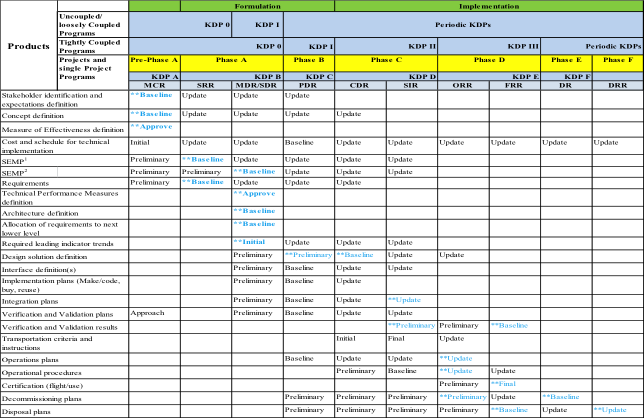
** Item is a required product for that review.
1For projects, single-project programs, and one-step AO programs.
2For uncoupled, tightly coupled, loosely coupled programs, and two-step AO programs.
5.2.2 Review Process and Practices
5.2.2.1 For each type of program/project, technical efforts are monitored throughout the life cycle to ensure that the technical goals of the project are being achieved and that the technical direction of the project is appropriate.
5.2.2.2 Technical teams shall monitor technical effort through periodic technical status reviews [SE-57].
5.2.2.3 A technical status review is an evaluation of the project, or element thereof, by the technical team and other knowledgeable participants for the purposes of:
a. Assessing the status of and progress toward accomplishing the planned activities.
b. Validating the technical tradeoffs explored and design solutions proposed.
c. Identifying technical weaknesses or marginal design and potential problems (risks) and recommending improvements and corrective actions.
d. Making judgments on the activities' readiness for the follow-on events, including additional future evaluation milestones to improve the likelihood of a successful outcome.
e. Making assessments and recommendations to the project team, Center, and Agency management.
f. Providing a historical record of decisions that were made during these formal reviews which can be referenced at a later date.
g. Assessing the technical risk status and current risk profile.
5.3 Completion of Life-cycle Reviews
5.3.1 Reviews are considered complete when the following are accomplished:
a. Agreement exists for the disposition of all Review Item Discrepancies (RIDs) and Request for Actions (RFAs).
b. The review board report and minutes are complete and distributed.
c. Agreement exists on a plan to address the issues and concerns in the review board's report.
d. Agreement exists on a plan for addressing the actions identified out of the review.
e. Liens against the review results are closed, or an adequate and timely plan exists for their closure.
f. Differences of opinion between the project under review and the review board(s) have been resolved, or a timely plan exists to resolve the issues.
g. A report is given by the review board chairperson to the appropriate management and governing program management committees (PMCs) charged with oversight of the project.
h. Appropriate procedures and controls are instituted to ensure that all actions from reviews are followed and verified through implementation to closure.
i. The Program/Project Decision Authority signs a decision memo documenting successful completion of the review.
DISTRIBUTION:
NODIS
This Document is Obsolete and Is No Longer Used.
Check the NODIS Library to access the current version:
http://nodis3.gsfc.nasa.gov
![[NASA Logo]](../Images/nasaball.gif)
